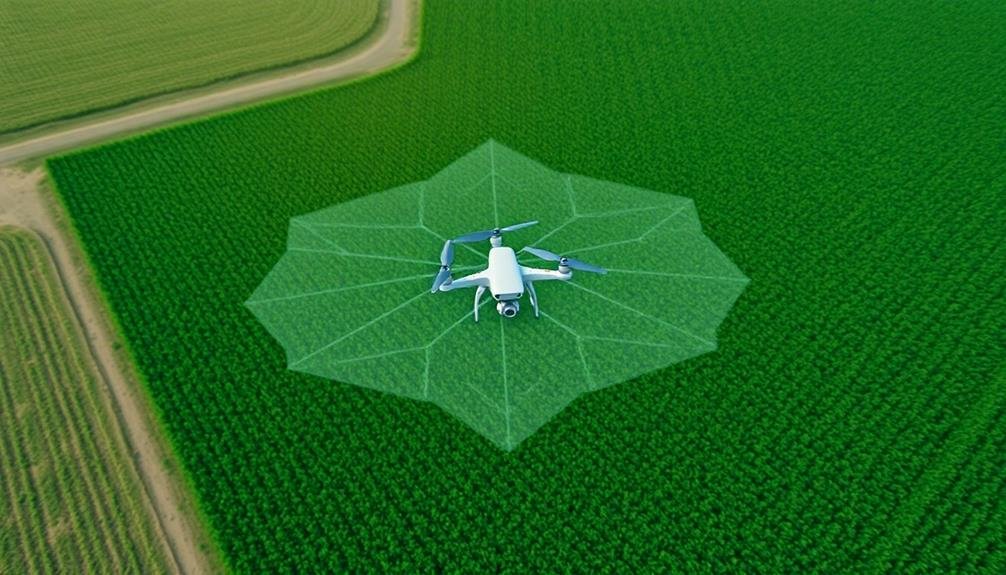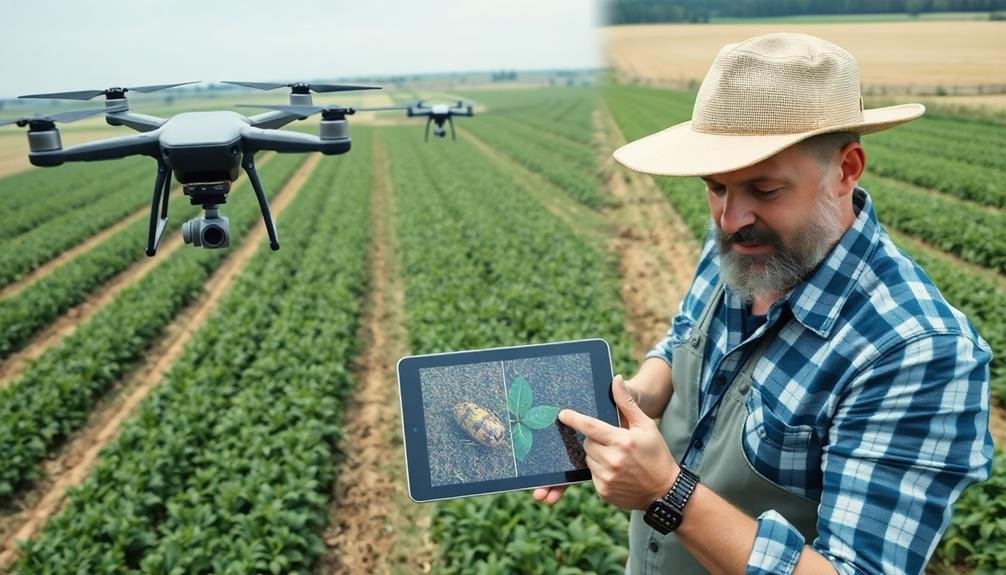To spot crop pests before damage occurs, use drones equipped with thermal imaging cameras. These can detect subtle temperature differences indicating pest presence or disease, even before visible signs appear. Next, integrate AI-powered pattern recognition systems to analyze the captured images, identifying anomalies and distinguishing healthy crops from infested ones. Finally, implement strategic flight planning by mapping your fields and scheduling regular flights during peak pest visibility times. Vary flight patterns and adjust altitudes based on crop height to guarantee thorough coverage. By adopting these advanced drone techniques, you'll stay one step ahead in protecting your crops from potential infestations.
Thermal Imaging for Early Detection

Drones equipped with thermal imaging cameras are revolutionizing pest detection in agriculture. You'll find that these advanced tools can spot pest infestations before they become visible to the naked eye. Thermal imaging detects subtle temperature differences in crops, which can indicate the presence of pests or disease.
When you use drones with thermal cameras, you're able to survey large areas quickly and efficiently. They can capture data from hundreds of acres in a single flight, giving you a thorough view of your fields. The images produced highlight areas of stress in the crops, which often correlate with pest activity.
You'll notice that infected plants typically have a higher temperature due to increased metabolic activity. This temperature difference shows up clearly in thermal images, allowing you to pinpoint problem areas precisely. By identifying these hotspots early, you can take targeted action before the pests spread.
Using this technology, you'll save time and resources by focusing your pest control efforts where they're needed most. It's a proactive approach that helps prevent widespread damage and crop loss, ultimately improving your yields and reducing pesticide use.
AI-Powered Pattern Recognition

While thermal imaging provides valuable insights, it's the integration of AI-powered pattern recognition that truly elevates drone-based pest detection. This advanced technology allows you to spot pest infestations with unprecedented accuracy and speed. AI algorithms analyze drone-captured images, identifying subtle patterns and anomalies that might escape the human eye.
You'll find that these systems can detect early signs of pest damage, such as slight discoloration or minor leaf deformations. They're trained on vast datasets of healthy and infested crops, enabling them to distinguish between normal plant variations and pest-induced changes.
As you use this technology, you'll notice it improves over time, learning from each new dataset it processes. The AI doesn't just identify problems; it can also predict potential infestation areas based on historical data and current conditions.
This proactive approach allows you to take preventive measures before pests can establish a foothold. You'll appreciate how the system can categorize and prioritize issues, helping you focus your efforts where they're most needed.
With AI-powered pattern recognition, you're not just reacting to pest problems; you're staying one step ahead of them.
Strategic Flight Planning

To maximize the effectiveness of your drone-based pest detection system, strategic flight planning is essential. Start by mapping out your field and dividing it into manageable sections. Consider factors like crop type, field size, and known problem areas when creating your flight plan.
Schedule regular flights at ideal times, such as early morning or late afternoon, when pests are more likely to be visible. Vary your flight patterns to guarantee thorough coverage, alternating between grid patterns and targeted sweeps of high-risk zones. Adjust your drone's altitude based on crop height and the specific pests you're targeting.
Don't forget to account for battery life and data storage capacity when planning longer missions. You'll want to maximize your drone's time in the air while making sure you don't run out of power mid-flight. Consider using automated flight planning software to refine your routes and increase efficiency.
Coordinate your drone flights with other farm activities to avoid interference and maintain safety.
Frequently Asked Questions
How Much Do Agricultural Drones Cost?
You'll find agricultural drones ranging from $1,000 to $25,000. Prices vary based on features, sensors, and payload capacity. Entry-level models are more affordable, while advanced drones with sophisticated imaging technology cost considerably more. Consider your specific needs when choosing.
What Licensing or Certifications Are Required to Operate Drones for Crop Monitoring?
You'll need a Remote Pilot Certificate from the FAA to operate drones for crop monitoring. You must pass an aeronautical knowledge test and be at least 16 years old. Renew your certification every 24 months.
Can Drones Be Used for Organic Farming Pest Detection?
Yes, you can use drones for organic farming pest detection. They'll help you spot infestations early, allowing for targeted interventions. You'll save time and resources while maintaining organic standards by avoiding blanket pesticide applications.
How Do Weather Conditions Affect Drone Performance in Pest Detection?
You'll find weather considerably impacts drone pest detection. Wind can disrupt flight, rain interferes with sensors, and extreme temperatures affect battery life. Cloudy days might limit visual data, while bright sunlight can cause glare on cameras.
What Is the Battery Life of Drones Used for Agricultural Purposes?
You'll find that agricultural drones typically have a battery life of 20-30 minutes. However, some advanced models can fly for up to an hour. It's essential to take into account this when planning your field surveys or pest detection missions.
In Summary
You've now got powerful tools to protect your crops from pests. By employing thermal imaging, you'll spot infestations before visible damage occurs. With AI-powered pattern recognition, you're able to quickly identify specific pest types and affected areas. Strategic flight planning guarantees you're covering your fields efficiently. Don't wait for pests to ravage your crops. Embrace these drone technologies, and you'll stay ahead of potential threats, safeguarding your harvest and maximizing your yields. Act now to revolutionize your pest management approach.

As educators and advocates for responsible drone use, we’re committed to sharing our knowledge and expertise with aspiring aerial photographers.




Leave a Reply